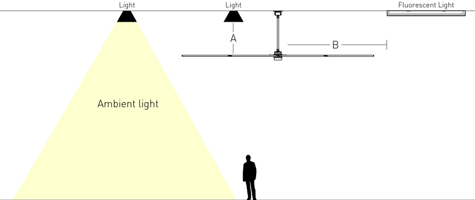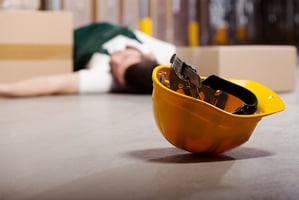We already know that HVLS ceiling fans provide a ton of benefits, including temperature regulation,...
5 Effects of Poor Lighting in the Workplace
One of the last things an industrial manager wants to worry about is the effects of poor lighting in the workplace. With employees to manage, maintenance procedures to complete, and production quotas to meet, there just isn’t enough time in the day for it.
However, if lighting conditions in your building aren’t sufficient, they could have an insidious impact on your employees and your business. In fact, 68% of employees complain about the lighting at work according to the American Society of Interior Design. What’s more, according to one UK report, having good lighting in their workspace is important to eight out of ten workers.
In this blog, we’ll highlight the main effects of poor lighting, as well as some possible solutions. You will also leave with useful tricks and tips sure to have your employees comfortable, content, and laser-focused while working.
The Main Effects of Poor Lighting in the Workplace
What is poor lighting? Well, poor lighting is really just a lack of quality light in a facility. Examples of poor lighting include fluorescent light, dark rooms with insufficient lighting, rooms with many shadows present, overly bright light, artificial light, and the presence of glare and/or flicker from existing lights. All of the aforementioned examples can have adverse effects on humans. Here are 5 effects of poor lighting in the workplace.
1. Physical Health
Poor lighting, flickering of lights, and glaring of lights can cause a wide range of adverse physical health problems. These include grogginess, sleepiness, insomnia, gastrointestinal distress, increased rate of errors, headaches, migraines, fatigue, agitation, nausea, back pain, lethargy, metabolic syndrome, decreased sleep quality, memory disruption, cognitive confusion, lower efficiency rate, and eye strain.
Now, while an employee’s eyesight might not be permanently damaged, if the lighting is poor in your workplace it could force them to strain their eyes to do their work.
According to Canada’s Centre for Occupational Health and Safety, poor lighting can not only strain the ocular system but also cause tension and stiffness in the neck and shoulder areas when employees use awkward physical postures to see.
In addition to poor daytime lighting, study shows that people working the night shift actually have a higher rate of cancer cases like breast cancer. Bone health, heart health, and increased body weight also were tied to those with less exposure to light.
2. Accidents
Many factories and distribution centers require employees to work with potentially dangerous tools and machinery. As mentioned above, poor lighting can cause grogginess. Additionally, when people can not see clearly because of a lack of sufficient light, accidents happen. Heavy machinery and tired employees do not mix. This equipment can cause serious damage to people or inventory if it malfunctions or is mishandled due to light issues or effects.
MacroAir regional sales manager, Mike Post, says, “If you have people working in that space who are packing boxes, inspecting product when it comes in from a vendor, counting items, etc., having that dark spot could create mistakes. They could overlook damage. They could put the wrong number of parts in a box.”
3. Mental Health
Not only does poor lighting in the workplace affect physical health, but it also affects mental health. Fluorescent lights can cause agitation which leads to stress and anxiety. Lack of light is also linked to Seasonal Affective Disorder (SAD) and depression. Having glare or flickering of the lights can produce a sound that becomes annoying. This causes extreme irritability and lack of focus, both of which tend to have a negative impact on one’s overall mental well-being.
4. Productivity
Your business depends on staff being able to do their jobs effectively. Workers must maintain a certain level of output so that orders can be shipped or products can be created at a sufficient rate.
Poor lighting slows down productivity because employees aren’t able to work fast when they can’t see well. It also slows down productivity, because poor lighting causes tiredness. While it might not cause any immediate impacts, if you don’t address a lighting problem quickly, the sustained effect on your productivity can lead to a drop in revenue that upper management will notice.
5. It Can Violate OSHA Regulations
The U.S. Occupational Safety and Health Administration’s Standard Number 1926.56 sets out guidelines for how much light is required in different kinds of workplace areas, from warehouses and corridors to equipment rooms and carpentry shops. These illumination guidelines are in foot candles, which is the amount of light provided by one candle in one square foot. Today, a more common measurement is lumens per square foot. No matter how you measure lighting in your building, if it’s not sufficient for your employees to see clearly, you could be subject to a violation of OSHA guidelines.
How Can I Fix Poor Lighting?
The good news is you can fix poor lighting, but you have to understand what GOOD lighting looks like. The most ideal lighting is natural light. However, if you do not have access to natural light in your space, there are other options. Introduce warm light whenever possible and stay away from fluorescent lighting and bright, artificial lighting.
Furthermore, look at the overall environment and how you can make adjustments to improve it. Consider the position of the light in your space, the mounting height of the lighting sources, the types of illumination you have, and the level of light distribution. Fixing and adjusting all of these things will greatly improve employee mood and alertness.
Another consideration is the correlated light temperature (CCT). CCT is basically how much yellow or blue tint is in the light that is emitted from a bulb. The proper rate of CCT is between 2200-6500 Kelvin degrees. Adding proper CCT in a work environment will improve overall motivation, health, cognition, and efficiency.
One more item to think about is the color rendering index (CRI). CRI is basically a test of the attributes of a light source. It basically is how we see the color to be based on the light. CRI is measured between 0-100 with a good rate of CRI between 80-90. Improper CRI and CCT rates can significantly affect the psychological function of a person.
Additional Quick Fixes to Help With Poor Lighting:
-
Add more lamps
-
Move your office configuration to take advantage of the natural light
-
Change the color of the room
-
Maximize the windows
-
Get outside when you can
-
Go for walks outside
-
Vitamin D
A New Way to Look at Office Lighting?
Companies are pushing the boundaries of what the physical office space is like inside and outside of the building. In today’s post-Covid world, many people are working remotely, where the physical environment and lighting may not be ideal for productivity. Companies are thinking outside the box and giving employees a unique and welcoming work experience to bring them together. These spaces have open concepts, flexible and inviting workspaces, and outdoor work and conference areas. The idea is to build a new work culture. One that is more laid back and more welcoming - all in efforts to make employee mental health and well-being a priority. When you harness natural elements, including natural light, you are positively affecting their bottom line, as well. Happier employees certainly are more productive.
Combine Proper Lighting with HVLS Fans for Maximum Benefits
Lighting and air movement really have much more in common than you may think. They both contribute greatly to the comfort level of your employees. These two items combined, proper lighting and HVLS fans will significantly affect your employees' productivity, safety, and health.
HVLS Fans and Lighting
If you do have HVLS ceiling fans, you must consider how the fan blades will affect the lights in the facility. If placed incorrectly, you can have light strobing. Mike Post explains why strobing can cause an unexpected problem in your space. He tells us that “if you make a decision to add HVLS fans to your facility, there’s a very good possibility that the HVLS fan is going to rotate underneath at least one light in your building. That is going to cause strobing, especially if you have metal halide lights.”
The last thing you want is the rotating blades of your new HVLS ceiling fan interfering with your ceiling lights. Proper fan placement will prevent strobing. The best HVLS fans either come with their own onboard lighting or can be integrated into your existing system without causing any strobing. Check out more specific information on how to prevent light strobing with HVLS fans.
If you have a need for more control over the climate in your space, let MacroAir help you find an HVLS fan to help you maintain an environment that is productive, safe, and comfortable for you and your employees.
Bottom Line
The effects of poor lighting in the workplace have a much bigger impact than one would think. It can affect the physical and mental well-being of you, your employees, and your business. Fortunately, there are simple and tangible solutions you can quickly implement that will make a big difference. Really, who wants to work in an environment that can actually cause your physical and mental health to deteriorate. Your employees are worth it. Furthermore, taking care of your employees will also have a positive impact on your business. Your customers are certainly worth it as well.
Additionally, if you currently have HVLS fans in your facility and are noticing a strobing effect with the lights, MacroAir is here to help! Light strobing is just one more lighting issue that can affect you and your employees. But it is fixable.
Click on the link below to learn how you can prevent light strobing today.

